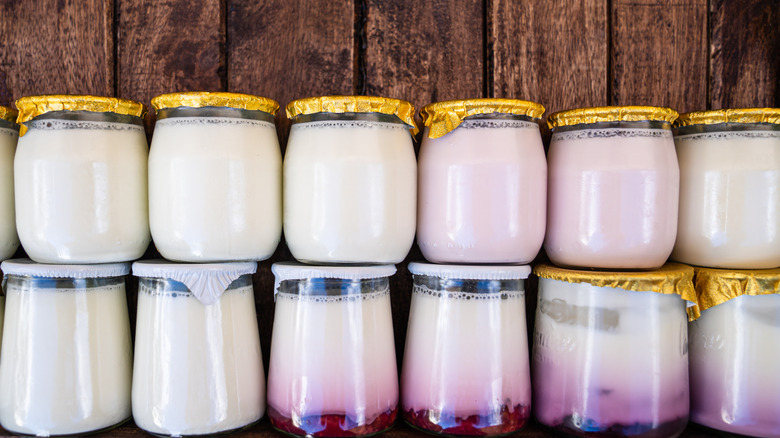What Makes French Yogurt Different From Other Varieties?
We may receive a commission on purchases made from links.
Yogurt may be a plain and simple food, but it has been enjoyed in a variety of ways for thousands of years. Likely named from the Turkish word yoğurmak (meaning to thicken), yogurt is nothing more than milk that's been fermented with bacteria, yet it has a litany of uses beyond being a nutritious breakfast. It's the perfect marinade for extra juicy chicken, an unexpected substitute for baking powder, and the key to protein-packed frozen treats. Since it's such a versatile ingredient, many cultures across the globe have refined and perfected their own styles of yogurt, including the notoriously dairy-loving French.
Though cooking with Greek yogurt has become increasingly popular over the years, French yogurt carries its own sophisticated style that is indicative of a culture that puts butter, cheese, and cream in just about everything. The main difference between French yogurt and other styles is that it's made and served in individual glass jars, as opposed to being batched from large vats. Since French yogurt sets in smaller portions, it's often thicker (and more firm) than traditional versions.
Additionally, French yogurt is also fattier and less tart than other styles, carrying a rich texture and subtle sweetness that (combined with adorable little glass pots) give it an air of decadent luxury. While it might be trickier to track down French-style yogurt than its Greek counterpart, you can easily shop for popular brands like Oui by Yoplait on Amazon.
How do American and Greek yogurts compare to French yogurt?
Despite the differences between styles, all yogurt starts out the same way: milk (usually from cows, but occasionally from goats or sheep) is heated up and pasteurized to kill harmful bacteria, then cooled briefly before being warmed again to add the helpful bacteria cultures that transform it into tangy yogurt. In France, this process would occur in individual jars, but traditional American yogurts are mass-produced in big batches. American yogurt is typically thinner than the French style, though some producers add milk powder for a thicker final product.
Greek yogurt, which is often lauded for its many gut health benefits, starts with the same base recipe as American yogurt. The difference lies in how the milk is treated after it has been cultured. Unlike American and French yogurt, Greek yogurt is strained to remove excess liquid and whey. This extra step creates a naturally thicker final product that is also higher in protein and probiotic content than other yogurts. Due to its luscious texture and rich tang, Greek yogurt is one of the most popular yogurt styles on the market, though French yogurt may give it a run for its money.


